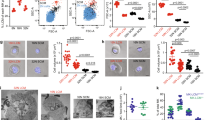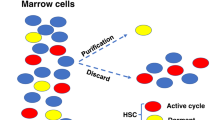Abstract
The haematopoietic stem cells which produce colonies in the spleen of irradiated mice (CFU-S)1 can differentiate into erythrocytes, granulocytes, megakaryocytes and B lymphocytes2–4. Although mast cell precursors are known to be present in the bone marrow5, spleen6, fetal liver7 and peripheral blood8 of mice, the relationship between the mast cell precursor and CFU-S has remained unclear. We have now made use of mice of two mutant genotypes to determine whether or not the tissue mast cell is a progeny of CFU-S. Giant granules of beige (C57BL/6-bgJ/bgJ, Chediak-Higashi syndrome) mice can be used for identification of the origin of both tissue mast cells5 and granulocytes9, and WBB6F1-W/Wν mice are useful recipients because they lack tissue mast cells owing to a defect in mast cell precursors10. We injected the cells from a single spleen colony into each WBB6F1-W/Wν mouse and demonstrated directly that the tissue mast cell is a progeny of CFU-S.
This is a preview of subscription content, access via your institution
Access options
Subscribe to this journal
Receive 51 print issues and online access
$199.00 per year
only $3.90 per issue
Buy this article
- Purchase on Springer Link
- Instant access to full article PDF
Prices may be subject to local taxes which are calculated during checkout
Similar content being viewed by others
References
Till, J. E. & McCulloch, E. A. Radiat. Res. 14, 213–222 (1961).
Wu, A. M., Till, J. E., Siminovitch, L. & McCulloch, E. A. J. Cell Physiol. 69, 177–184 (1967).
Curry, J. L. & Trentin, J. J. Devl Biol. 15, 395–413 (1967).
Lala, P. K. & Johnson, G. R. J. exp. Med. 148, 1468–1477 (1978).
Kitamura, Y., Shimada, M., Hatanaka, K. & Miyano, Y. Nature 268, 442–443 (1977).
Kitamura, Y. et al. J. exp. Med. 150, 482–490 (1979).
Kitamura, Y., Shimada, M. & Go, S. Devl Biol. 70, 510–514 (1979).
Kitamura, Y., Hatanaka, K., Murakami, M. & Shibata, H. Blood 53, 1085–1088 (1979).
Murphy, E. D., Harrison, D. E. & Roth, J. B. Transplantation 15, 526–530 (1973).
Kitamura, Y., Go, S. & Hatanaka, K. Blood 52, 447–452 (1978).
Harrison, D. E., Astle, C. M. & DeLaittre, J. A. Blood 54, 1152–1157 (1979).
Whitney, J. B. III Biochem. Genet. 16, 667–672 (1978).
Schofield, R. & Pozzi, L. V. in Advances in Transplantation. Proceedings of the First International Congress of the Transplantation Society (eds Dausset, J., Hamburger, J. & Mathé, G.) 423–425 (Munksgaard, Copenhagen, 1969).
Metcalf, D. & Moore, M. A. S. in Hematopoietic Cells 90–92 (North-Holland, Amsterdam, 1971).
Author information
Authors and Affiliations
Rights and permissions
About this article
Cite this article
Kitamura, Y., Yokoyama, M., Matsuda, H. et al. Spleen colony-forming cell as common precursor for tissue mast cells and granulocytes. Nature 291, 159–160 (1981). https://doi.org/10.1038/291159a0
Received:
Accepted:
Issue Date:
DOI: https://doi.org/10.1038/291159a0
This article is cited by
-
Hematopoietic cytokines for cardiac repair: mobilization of bone marrow cells and beyond
Basic Research in Cardiology (2011)
-
Molecular regulation of mast cell development and maturation
Molecular Biology Reports (2010)
-
Involvement of mast cells by the malignant process in patients with Philadelphia chromosome negative myeloproliferative neoplasms
Leukemia (2009)
-
Gastrointestinal stromal tumors: past, present, and future
Journal of Gastroenterology (2008)
-
Cytokines Regulate Development of Human Mast Cells from Hematopoietic Progenitors
International Journal of Hematology (2002)
Comments
By submitting a comment you agree to abide by our Terms and Community Guidelines. If you find something abusive or that does not comply with our terms or guidelines please flag it as inappropriate.



